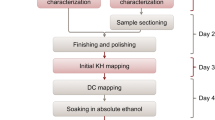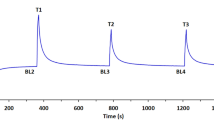Abstract
Objectives
To investigate radiant energy, microhardness, and temperature rise in eight resin composites cured with a blue or violet-blue curing unit, using a curing protocol which exceeded manufacturer recommendations.
Materials and methods
Cylindrical composite specimens (d = 8 mm, h = 2 or 4 mm, n = 5 per experimental group) were light-cured for 30 s. Light transmittance through specimens was recorded in real time to calculate radiant energy delivered to the specimen bottom. Vickers microhardness was used to evaluate the polymerization effectiveness at depth. Temperature rise at the bottom of the specimens was measured in real time using a T-type thermocouple.
Results
Radiant energy delivered from the blue and violet-blue curing unit amounted to 19.4 and 28.6 J/cm2, which was 19 and 13% lower than specified by the manufacturer. Radiant energies at bottom surfaces (0.2–7.5 J/cm2) were significantly affected by material, thickness, and curing unit. All of the composites reached 80% of maximum microhardness at clinically relevant layer thicknesses. The benefit of using the higher-irradiance violet-blue curing unit was identified only in composites containing alternative photoinitiators. Temperature rise during curing ranged from 4.4 to 9.3 °C and was significantly reduced by curing with the lower-intensity blue curing unit and by increasing layer thickness.
Conclusion
Curing for 30 s, which can be regarded as extended considering manufacturer specifications, produced radiant energies which are in line with the recommendations from the current scientific literature, leading to adequate curing efficiency and acceptable temperature rise.
Clinical relevance
Extended curing time should be used to minimize concerns regarding undercuring of composite restorations.






Similar content being viewed by others
References
Price RB (2018) The dental curing light. In: Miletic V (ed) Dental composite materials for direct restorations. Springer International, Berlin, pp 43–62. https://doi.org/10.1007/978-3-319-60961-4_4
Rencz A, Hickel R, Ilie N (2012) Curing efficiency of modern LED units. Clin Oral Investig 16(1):173–179. https://doi.org/10.1007/s00784-010-0498-3
Nomoto R, McCabe JF, Hirano S (2004) Comparison of halogen, plasma and LED curing units. Oper Dent 29(3):287–294
Tarle Z, Attin T, Marovic D, Andermatt L, Ristic M, Taubock TT (2015) Influence of irradiation time on subsurface degree of conversion and microhardness of high-viscosity bulk-fill resin composites. Clin Oral Investig 19(4):831–840. https://doi.org/10.1007/s00784-014-1302-6
Karacolak G, Turkun LS, Boyacioglu H, Ferracane JL (2018) Influence of increment thickness on radiant energy and microhardness of bulk-fill resin composites. Dent Mater J 37(2):206–213. https://doi.org/10.4012/dmj.2017-032
Leprince J, Devaux J, Mullier T, Vreven J, Leloup G (2010) Pulpal-temperature rise and polymerization efficiency of LED curing lights. Oper Dent 35(2):220–230. https://doi.org/10.2341/09-203-L
Durner J, Obermaier J, Draenert M, Ilie N (2012) Correlation of the degree of conversion with the amount of elutable substances in nano-hybrid dental composites. Dent Mater 28(11):1146–1153. https://doi.org/10.1016/j.dental.2012.08.006
Miletic V, Pongprueksa P, De Munck J, Brooks NR, Van Meerbeek B (2017) Curing characteristics of flowable and sculptable bulk-fill composites. Clin Oral Investig 21(4):1201–1212. https://doi.org/10.1007/s00784-016-1894-0
Ernst CP, Price RB, Callaway A, Masek A, Schwarm H, Rullmann I, Willershausen B, Ehlers V (2018) Visible light curing devices—irradiance and use in 302 German dental offices. J Adhes Dent 20(1):41–55. https://doi.org/10.3290/j.jad.a39881
Zorzin J, Maier E, Harre S, Fey T, Belli R, Lohbauer U, Petschelt A, Taschner M (2015) Bulk-fill resin composites: polymerization properties and extended light curing. Dent Mater 31(3):293–301. https://doi.org/10.1016/j.dental.2014.12.010
Hogg C, Maier M, Dettinger-Maier K, He X, Rothmund L, Kehe K, Hickel R, Reichl FX (2016) Effect of various light curing times on the elution of composite components. Clin Oral Investig 20(8):2113–2121. https://doi.org/10.1007/s00784-015-1698-7
Ilie N, Obermaier J, Durner J (2014) Effect of modulated irradiation time on the degree of conversion and the amount of elutable substances from nano-hybrid resin-based composites. Clin Oral Investig 18(1):97–106. https://doi.org/10.1007/s00784-013-0934-2
Price RB, Labrie D, Rueggeberg FA, Sullivan B, Kostylev I, Fahey J (2014) Correlation between the beam profile from a curing light and the microhardness of four resins. Dent Mater 30(12):1345–1357. https://doi.org/10.1016/j.dental.2014.10.001
Palin WM, Leprince JG, Hadis MA (2018) Shining a light on high volume photocurable materials. Dent Mater 34(5):695–710. https://doi.org/10.1016/j.dental.2018.02.009
Shortall A, El-Mahy W, Stewardson D, Addison O, Palin W (2013) Initial fracture resistance and curing temperature rise of ten contemporary resin-based composites with increasing radiant exposure. J Dent 41(5):455–463. https://doi.org/10.1016/j.jdent.2013.02.002
Baroudi K, Silikas N, Watts DC (2009) In vitro pulp chamber temperature rise from irradiation and exotherm of flowable composites. Int J Paediatr Dent 19(1):48–54. https://doi.org/10.1111/j.1365-263X.2007.00899.x
Yazici AR, Muftu A, Kugel G, Perry RD (2006) Comparison of temperature changes in the pulp chamber induced by various light curing units, in vitro. Oper Dent 31(2):261–265. https://doi.org/10.2341/05-26
Ozturk B, Ozturk AN, Usumez A, Usumez S, Ozer F (2004) Temperature rise during adhesive and resin composite polymerization with various light curing sources. Oper Dent 29(3):325–332
Vandewalle KS, Roberts HW, Tiba A, Charlton DG (2005) Thermal emission and curing efficiency of LED and halogen curing lights. Oper Dent 30(2):257–264
Yap AU, Soh MS (2003) Thermal emission by different light-curing units. Oper Dent 28(3):260–266
Goodis HE, White JM, Gamm B, Watanabe L (1990) Pulp chamber temperature changes with visible-light-cured composites in vitro. Dent Mater 6(2):99–102. https://doi.org/10.1016/S0109-5641(05)80038-7
Ratih DN, Palamara JE, Messer HH (2007) Temperature change, dentinal fluid flow and cuspal displacement during resin composite restoration. J Oral Rehabil 34(9):693–701. https://doi.org/10.1111/j.1365-2842.2007.01764.x
Zach L, Cohen G (1965) Pulp response to externally applied heat. Oral Surg Oral Med Oral Pathol 19:515–530
Baldissara P, Catapano S, Scotti R (1997) Clinical and histological evaluation of thermal injury thresholds in human teeth: a preliminary study. J Oral Rehabil 24(11):791–801. https://doi.org/10.1111/j.1365-2842.1997.tb00278.x
Lin M, Xu F, Lu TJ, Bai BF (2010) A review of heat transfer in human tooth—experimental characterization and mathematical modeling. Dent Mater 26(6):501–513. https://doi.org/10.1016/j.dental.2010.02.009
Uhl A, Mills RW, Jandt KD (2003) Polymerization and light-induced heat of dental composites cured with LED and halogen technology. Biomaterials 24(10):1809–1820. https://doi.org/10.1016/s0142-9612(02)00585-9
Hannig M, Bott B (1999) In-vitro pulp chamber temperature rise during composite resin polymerization with various light-curing sources. Dent Mater 15(4):275–281. https://doi.org/10.1016/S0109-5641(99)00047-0
Par M, Gamulin O, Marovic D, Klaric E, Tarle Z (2014) Effect of temperature on post-cure polymerization of bulk-fill composites. J Dent 42(10):1255–1260. https://doi.org/10.1016/j.jdent.2014.08.004
Par M, Gamulin O, Marovic D, Skenderovic H, Klaric E, Tarle Z (2016) Conversion and temperature rise of remineralizing composites reinforced with inert fillers. J Dent 48:26–33. https://doi.org/10.1016/j.jdent.2016.03.008
Sever I, Klaric E, Tarle Z (2016) Accounting for measurement reliability to improve the quality of inference in dental microhardness research: a worked example. Clin Oral Investig 20(6):1143–1149. https://doi.org/10.1007/s00784-015-1600-7
Price RB, Fahey J, Felix CM (2010) Knoop hardness of five composites cured with single-peak and polywave LED curing lights. Quintessence Int 41(10):e181–e191
Santini A, Miletic V, Swift MD, Bradley M (2012) Degree of conversion and microhardness of TPO-containing resin-based composites cured by polywave and monowave LED units. J Dent 40(7):577–584. https://doi.org/10.1016/j.jdent.2012.03.007
Gomes M, DeVito-Moraes A, Francci C, Moraes R, Pereira T, Froes-Salgado N, Yamazaki L, Silva L, Zezell D (2013) Temperature increase at the light guide tip of 15 contemporary LED units and thermal variation at the pulpal floor of cavities: an infrared thermographic analysis. Oper Dent 38(3):324–333. https://doi.org/10.2341/12-060-L
Shimokawa CAK, Turbino ML, Giannini M, Braga RR, Price RB (2018) Effect of light curing units on the polymerization of bulk fill resin-based composites. Dent Mater 34:1211–1221. https://doi.org/10.1016/j.dental.2018.05.002
Price RB, Fahey J, Felix CM (2010) Knoop microhardness mapping used to compare the efficacy of LED, QTH and PAC curing lights. Oper Dent 35(1):58–68. https://doi.org/10.2341/09-055-L
Shimokawa C, Sullivan B, Turbino ML, Soares CJ, Price RB (2017) Influence of emission spectrum and irradiance on light curing of resin-based composites. Oper Dent 42(5):537–547. https://doi.org/10.2341/16-349-L
Palin WM, Senyilmaz DP, Marquis PM, Shortall AC (2008) Cure width potential for MOD resin composite molar restorations. Dent Mater 24(8):1083–1094. https://doi.org/10.1016/j.dental.2008.01.001
Price RB, Felix CA (2009) Effect of delivering light in specific narrow bandwidths from 394 to 515nm on the micro-hardness of resin composites. Dent Mater 25(7):899–908. https://doi.org/10.1016/j.dental.2009.01.098
Flury S, Peutzfeldt A, Lussi A (2014) Influence of increment thickness on microhardness and dentin bond strength of bulk fill resin composites. Dent Mater 30(10):1104–1112. https://doi.org/10.1016/j.dental.2014.07.001
Moszner N, Fischer UK, Ganster B, Liska R, Rheinberger V (2008) Benzoyl germanium derivatives as novel visible light photoinitiators for dental materials. Dent Mater 24(7):901–907. https://doi.org/10.1016/j.dental.2007.11.004
El-Damanhoury H, Platt J (2014) Polymerization shrinkage stress kinetics and related properties of bulk-fill resin composites. Oper Dent 39(4):374–382. https://doi.org/10.2341/13-017-L
AlShaafi MM, Haenel T, Sullivan B, Labrie D, Alqahtani MQ, Price RB (2016) Effect of a broad-spectrum LED curing light on the Knoop microhardness of four posterior resin based composites at 2, 4 and 6-mm depths. J Dent 45:14–18. https://doi.org/10.1016/j.jdent.2015.11.004
Rodrigues JA, Tenorio IP, Mello GBR, Reis AF, Shen C, Roulet JF (2017) Comparing depth-dependent curing radiant exposure and time of curing of regular and flow bulk-fill composites. Braz Oral Res 31:e65. https://doi.org/10.1590/1807-3107BOR-2017.vol31.0065
Jakubiak J, Allonas X, Fouassier JP, Sionkowska A, Andrzejewska E, Linden LÅ, Rabek JF (2003) Camphorquinone–amines photoinitating systems for the initiation of free radical polymerization. Polymer 44(18):5219–5226. https://doi.org/10.1016/s0032-3861(03)00568-8
Bouillaguet S, Caillot G, Forchelet J, Cattani-Lorente M, Wataha JC, Krejci I (2005) Thermal risks from LED- and high-intensity QTH-curing units during polymerization of dental resins. J Biomed Mater Res B Appl Biomater 72(2):260–267. https://doi.org/10.1002/jbm.b.30143
Al-Qudah AA, Mitchell CA, Biagioni PA, Hussey DL (2005) Thermographic investigation of contemporary resin-containing dental materials. J Dent 33(7):593–602. https://doi.org/10.1016/j.jdent.2005.01.010
Rueggeberg FA, Giannini M, Arrais CAG, Price RBT (2017) Light curing in dentistry and clinical implications: a literature review. Braz Oral Res 31(suppl 1):e61. https://doi.org/10.1590/1807-3107BOR-2017.vol31.0061
Park SH, Roulet JF, Heintze SD (2010) Parameters influencing increase in pulp chamber temperature with light-curing devices: curing lights and pulpal flow rates. Oper Dent 35(3):353–361. https://doi.org/10.2341/09-234-L
Lloyd CH, Brown EA (1984) The heats of reaction and temperature rises associated with the setting of bonding resins. J Oral Rehabil 11(4):319–324. https://doi.org/10.1111/j.1365-2842.1984.tb00582.x
Daronch M, Rueggeberg FA, Hall G, De Goes MF (2007) Effect of composite temperature on in vitro intrapulpal temperature rise. Dent Mater 23(10):1283–1288. https://doi.org/10.1016/j.dental.2006.11.024
Asmussen E, Peutzfeldt A (2005) Temperature rise induced by some light emitting diode and quartz-tungsten-halogen curing units. Eur J Oral Sci 113(1):96–98. https://doi.org/10.1111/j.1600-0722.2004.00181.x
Runnacles P, Arrais CA, Pochapski MT, Dos Santos FA, Coelho U, Gomes JC, De Goes MF, Gomes OM, Rueggeberg FA (2015) In vivo temperature rise in anesthetized human pulp during exposure to a polywave LED light curing unit. Dent Mater 31(5):505–513. https://doi.org/10.1016/j.dental.2015.02.001
Acknowledgments
Composite materials Tetric EvoCeram and Tetric EvoCeram Bulk Fill and curing units were generously provided by Ivoclar Vivadent.
Funding
This work received no external funding.
Author information
Authors and Affiliations
Corresponding author
Ethics declarations
Conflict of interest
The authors declare no conflict of interest.
Ethical approval
This article does not contain any studies with human participants or animals performed by any of the authors.
Informed consent
For this type of study, formal consent is not required.
Additional information
Publisher’s note
Springer Nature remains neutral with regard to jurisdictional claims in published maps and institutional affiliations.
Rights and permissions
About this article
Cite this article
Par, M., Repusic, I., Skenderovic, H. et al. The effects of extended curing time and radiant energy on microhardness and temperature rise of conventional and bulk-fill resin composites. Clin Oral Invest 23, 3777–3788 (2019). https://doi.org/10.1007/s00784-019-02807-1
Received:
Accepted:
Published:
Issue Date:
DOI: https://doi.org/10.1007/s00784-019-02807-1




